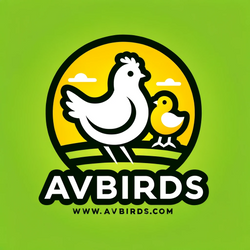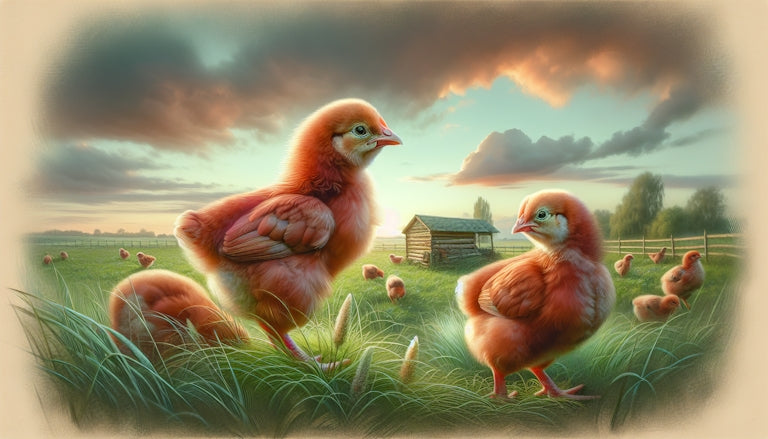Rhode Island Red chicks are a top pick for home flocks, thanks to their hardy nature and prolific egg laying. In this guide, you’ll discover exactly what these spirited birds need to thrive on your farm.
By the end, you’ll know how to care for these dual-purpose chicks from day one through their first egg season.
Get To Know The Breed
Rhode Island Reds trace back to 50 generations of pedigree breeding at Shaver Poultry Farms, making them a true heritage chicken breed. They pack both beauty and brawn, with rich red feathers and a single red comb that stands tall.
These birds weigh in at about 6–7 pounds for hens and 8–9 pounds for roosters when mature, and they hit breeding age around 12–16 weeks (University of Alberta). You’ll love how these chickens tolerate cold winters and hot summers alike, so long as you give them shelter, fresh water, and balanced feed.
Key Breed Highlights
- Egg Production: 250–300 large brown eggs per year (University of Alberta)
- Lifespan: 5–8 years with proper care, sometimes up to 10 in pastured setups
- Temperament: Curious and assertive, they may follow you around like puppy dogs
- Maintenance: Independent foragers, low fuss once settled
If you’re into heritage lines, check our rare chicken breeds for sale to compare other sturdy options.
Set Up Your Brooder
Think of your brooder like a nursery, it’s your chicks’ first home. Aim for a brooder box that’s predator proof and easy to clean. Line the floor with pine shavings, avoiding slippery newspaper, so tiny feet get good traction.
You’ll need a steady heat source, like a heat lamp or plate, set to about 95°F at chick level and dropping 5°F each week. Place a thermometer at floor height to monitor temperature without guesswork.
Essential Brooder Supplies
- Chick brooder supplies kit or DIY box
- Heat lamp or brooder plate with guard
- Shallow waterer and feeder (chicken feeders and waterers)
- Soft bedding (pine shavings or hemp)
Worried about litter eating? Try a low-profile waterer and a taped-down cardboard barrier around feeders. That keeps bedding drier and chicks happier.
Choose The Right Feed
Good nutrition sets the stage for healthy growth and solid egg laying later on. Offer a chick starter feed with 18–20% protein for the first 8 weeks. Then transition to grower feed at 16–18% protein until egg pullets hit 18 weeks.
Once eggs arrive, switch to a layer ration with 16% protein and added calcium for strong shells. Grit or crushed oyster shell can stay available free choice.
Feed Schedule Table
| Stage | Age Range | Feed Type | Protein | Purpose |
|---|---|---|---|---|
| Starter | 0–8 weeks | Chick Starter | 18–20% | Promotes rapid growth |
| Grower | 8–18 weeks | Grower Feed | 16–18% | Builds muscle and frame |
| Layer | 18+ weeks | Layer Feed | 16% | Supports daily egg production |
Want a head start on adult layers? Explore our brown egg layers for sale to compare laying birds and their feed needs.
Track Growth And Health
Regular check-ins help you spot any issues before they become serious. Weigh chicks weekly on a kitchen scale – they should reach about half their adult weight by 10 weeks.
Recognize Growth Milestones
- Week 4: Downy fluff gives way to pin feathers
- Week 8: Average weight 2.5–3 pounds
- Week 12: Feathering nearly complete, depending on coop conditions
Transition To Your Coop
At 6–8 weeks, your flock is ready to move into a secure coop. Make sure the coop floor is clean and dry, with roosting bars installed about 12 inches off the ground. A little porch or run gives them fresh air without risking predators.
Worried about mites or lice? Schedule a coop clean every month, spray recommended poultry-safe disinfectant, and swap bedding regularly.
Expect Consistent Egg Laying
Rhode Island Reds begin laying around 18–20 weeks when they get 14–16 hours of light per day. You’ll likely see five to six eggs each week per hen, enough for daily breakfast omelets or canning projects.
Boost Shell Strength
- Offer crushed oyster shell free choice
- Keep fresh water flowing, especially in heat
- Maintain consistent feed availability
With their gorgeous brown shells, these hens rank high among our brown egg layers for sale. And if you’re looking to add more young stock, check out our day-old chicks for sale section.
Enjoy Dual-Purpose Benefits
One of the best perks of this breed is its versatility. You get reliable eggs and a nice size table bird when you raise broilers from straight-run stock. Plus, they’re great foragers that help keep your yard free of bugs.
Why Farmers Love Them
- Free-range efficiency cuts feed bills
- Friendly personalities make them backyard favorites
- Strong immunity helps fend off common poultry ailments
Looking for more meat-and-egg options? Browse our dual-purpose chickens for sale to see how Rhode Island Reds stack up against other backyard staples.
Key Takeaways And Next Steps
- Rhode Island Red chicks deliver hearty health, reliable laying, and tasty meat
- Provide a warm, predator-safe brooder, then transition to a clean, dry coop
- Follow a simple feed schedule from high-protein starter to calcium-rich layer feed
- Track growth with weekly weigh-ins and stay on top of coop hygiene
- Enjoy 250–300 large brown eggs annually plus robust table birds
Ready to grow your flock or weigh other options? Head over to our breed selector to pinpoint the perfect chicks for your homestead. Let us know your favorite Rhode Island Red moment in the comments below!

